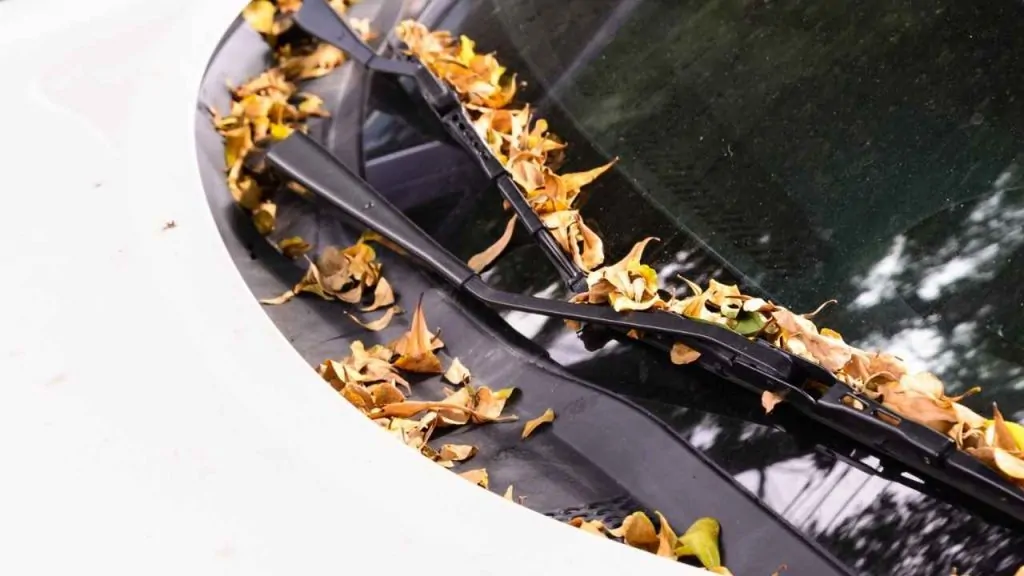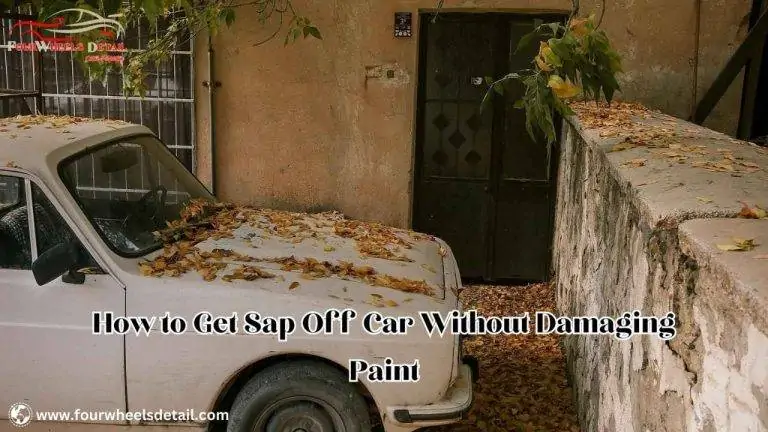Using a commercial sap remover, alcohol, or clay bar, acting fast is the best way to prevent permanent damage. Many car owners unknowingly use harsh chemicals or abrasive materials like household cleaners, which can lead to paint scratches, dulling, or discoloration. Improper techniques like aggressive scrubbing or using sharp tools further contribute to this damage. Unlock the secrets to get sap off your car, given below:
Table of Contents
ToggleWhat is Sap, and Why is It a Problem for Cars?
Sap is a sticky, organic substance secreted by certain trees as part of their natural growth and healing process. While sap may not seem like an immediate threat, it can become a significant issue when it lands on a car’s exterior. Sap is more likely to land on your vehicle when parked under trees like pine, maple, or oak.
Over time, sap hardens under the sun, making it challenging to remove without damaging the car’s paint. If left untreated for too long, sap can etch into the clear coat and even penetrate the paint, causing permanent stains or discoloration. This is particularly problematic if your vehicle has dark paint, as the contrast with the hardened sap can be especially visible. Acting quickly is essential to prevent long-term damage.
Identifying Sap on Your Car
Identifying sap on your vehicle is the first step toward removing it. Sap usually appears as small, sticky droplets, often yellowish, brown, or amber in color. It may not always be immediately obvious, especially if you’re unfamiliar with what to look for. Drivers often mistake sap for bird droppings or pollen, as these other substances can also cling to the car’s surface and cause similar damage. While sap is most common from trees like pines, different trees can also cause sap-related problems. Pine trees tend to produce a sticky resin, while other species may leave behind a different type of sap that still hardens over time.
How to Remove Sap from a Car

There are several effective ways to remove sap from your car, ranging from commercial products to homemade solutions. The method you choose depends on how long the sap has been sitting on the vehicle and the extent of the contamination:
1. Using a Commercial Sap Remover
Commercial sap removers, such as Turtle Wax Bug & Tar Remover or Goo Gone, are designed specifically to break down sticky substances like sap. These products are safe for automotive use and work well on both fresh and hardened sap.
- How to Choose: Make sure to select a product that is specifically labeled as safe for use on automotive paint. General-purpose removers could harm your car’s finish.
- Application: Spray the product directly onto the sap. Allow it to sit for about a minute to penetrate the sap. Afterward, gently wipe it off with a microfiber cloth. Be patient—it may take more than one application to fully remove stubborn sap.
2. DIY Sap Remover: Rubbing Alcohol
If you don’t have a commercial remover on hand, isopropyl alcohol or even hand sanitizer can work in a pinch. Both contain alcohol, which effectively breaks down sap.
- How to Use: Pour a small amount of rubbing alcohol onto a microfiber cloth and gently rub the sap spot. Be sure to test the solution in a less visible area of your car first to ensure it doesn’t cause any damage to the paint.
3. Clay Bar for Stubborn Sap
A clay bar is a versatile tool in car detailing. It’s particularly effective for removing stubborn contaminants like tree sap, tar, and other embedded debris.
- How to Use: Wash your car first to remove any surface dirt. Then, lubricate the area with a detailing spray and gently rub the clay bar over the sap spot. The clay bar works by picking up the contaminants as it glides over the surface, leaving the area smooth.
4. Rubbing Compound for Tough Sap
If the sap has been sitting on the car for a long time and hardened significantly, you may need to use a rubbing compound. This is a more aggressive solution but should be used with care.
- How to Use: Apply a small amount of rubbing compound to a soft cloth and gently buff the sap spot in circular motions. Be cautious, as rubbing compound can wear away the clear coat if overused.
5. Polishing Compound for Aftercare
After using harsher methods like rubbing compound or clay bar, you might notice the affected area looks dull. A polishing compound can restore shine to the surface.
- How to Use: Apply the compound with a clean cloth and work it into the surface in small circles. This will restore the gloss and help the area blend in with the rest of the car.
Important Tips for Removing Sap
Here are some essential tips to keep in mind when dealing with tree sap:
- Act Quickly: The longer sap stays on your car, the harder it becomes to remove, and the more likely it is to damage the paint.
- Avoid Harsh Chemicals: Household cleaners like vinegar, nail polish remover, or WD-40 can do more harm than good, stripping away the clear coat and causing permanent damage.
- Use a Microfiber Cloth: Always use a soft microfiber cloth to avoid scratching the paint while cleaning.
- Be Patient: Some sap stains may take several rounds of cleaning to remove completely.
Preventing Sap Buildup
Preventing sap from landing on your car is easier than dealing with the hassle of removing it. Here are a few tips:
- Park Smart: Avoid parking directly under trees, especially those known to produce sap like pine, oak, and maple.
- Use a Car Cover: If you must park under trees regularly, investing in a car cover can save you a lot of trouble.
- Regular Wash and Wax: Regularly washing and waxing your car creates a protective barrier on the surface, making it easier to clean off sap and other contaminants.
FAQs: Common Questions About Sap Removal
Does Tree Sap Permanently Damage Paint?
Yes, if sap is left on your car for too long, it can eat through the clear coat and damage the paint. Removing sap promptly is key to preventing permanent damage.
Can Sap Be Removed from Glass and Plastic Parts?
Absolutely. The same methods used for car paint, such as rubbing alcohol or commercial sap removers, can be applied to glass and plastic trim. Be sure to clean and polish these surfaces afterward.
Is Clay Bar Safe for Sap Removal?
Yes, a clay bar is a safe and effective way to remove sap without damaging the paint, especially if the sap is dry or hardened.
What to Do if Sap is Stuck on Your Car’s Paint?
If the sap has hardened, start with a clay bar or rubbing compound, then follow up with a polishing compound to restore the shine.
Will Vinegar Remove Tree Sap From Car?
Yes, vinegar can be used to remove tree sap from a car. Its acidity helps to break down the sap, making it easier to wipe away.However, it’s important to test it on a small, inconspicuous area first to ensure it doesn’t damage the paint.
How Do You Remove Sap From Car Glass?
Use Rubbing Alcohol Or A Commercial Sap Remover On A Microfiber Cloth. Apply Gently On The Sap, Let It Sit Briefly, And Wipe Off For A Clear, Sap-Free Surface.
Does Hand Sanitizer Remove Sap From Cars?
Yes, Hand Sanitizer With Alcohol Can Help Break Down Sap. Apply A Small Amount To A Cloth, Rub Gently, And Wipe Clean. Test On A Small Area First.
What Soap Removes Sap From Car?
Use Car-Specific Soaps For Basic Sap Removal, Or Add A Few Drops Of Dish Soap To Water. For Stubborn Sap, Follow With Alcohol Or Sap Remover Products.
How To Remove Red Spots On Car From Tree?
Rubbing Alcohol Or An All-Purpose Bug And Tar Remover Can Help. Apply With A Microfiber Cloth, Rub Gently, And Rinse To Avoid Paint Damage.
How To Remove Hardened Tree Sap From Car Windshield?
Apply Rubbing Alcohol To A Microfiber Cloth, Press Over Sap To Soften It, And Gently Rub Until Removed. For Tough Spots, Use A Plastic Scraper Carefully.
How Do You Get Old Dried Sap Off A Car?
Use Rubbing Alcohol Or A Clay Bar To Soften And Remove Dried Sap. Gently Rub The Area, Reapplying As Needed, Then Polish To Restore Shine.
Does Baby Oil Remove Sap?
Yes, Baby Oil Can Soften Sap. Apply A Small Amount, Let It Sit, And Gently Rub Off With A Soft Cloth. Wash Afterward To Remove Any Residue.
Wd-40 To Remove Sap From Car?
Wd-40 Works To Loosen Sap. Spray On The Sap Spot, Wait A Minute, And Gently Wipe Off. Wash The Area With Soap And Water Afterward.
If you want to learn more about car cleaning and detailing, you can look more on our website fourwheelsdetail.com

Hi! I’m Harry, With over a decade of experience in car detailing and cleaning, I specialize in restoring vehicles to their pristine best. Passionate about sharing expert tips on fourwheelsdetail.com, I’m here to help readers maintain their cars’ beauty, from paint protection to tackling tough stains.

